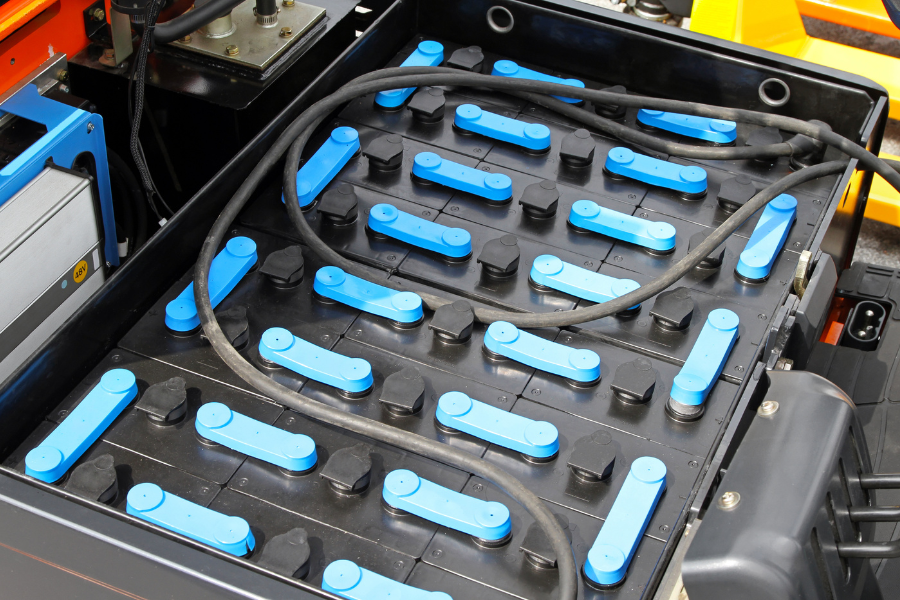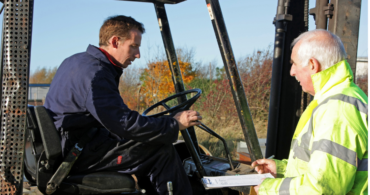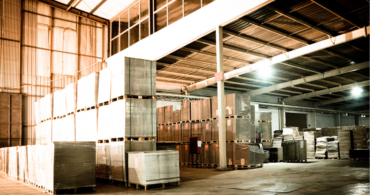Lead acid vs lithium-ion batteries: it’s a question that has plagued philosophers for centuries, or at least the decades since the invention of lithium-ion technology. However, as with many philosophical debates, the forest is the topic, but the individual trees are actually the most important. The question is not, “Are lithium batteries better than lead acid batteries?” It is “Which batteries are better for your business’s needs?”
Different operations have different requirements, and no one can diagnosis your unique needs remotely. That’s why Texas Motive Solutions offers an on-site, complimentary forklift fleet performance analysis.
However, regarding the perpetual lead acid battery vs lithium ion debate (otherwise known as the lithium battery vs regular battery dispute), let’s look at some of the key issues and see if it provides some guidance on which batteries may be best for you.
Lithium-ion battery vs lead acid battery: What are they?
Lead-acid batteries
Although they sound like the name of a ’90s thrash metal group, lead acid batteries have been around for nearly 200 years. Developed in 1859 by the French physician Gaston Planté, lead acid batteries were the first rechargeable batteries designed for commercial use. Don’t worry; you’re not dealing with the same lead acid battery technology as some guy maintaining the lights in a Parisian train carriage. There have been many refinements and improvements to these batteries over the years.
There are four main components inside a lead acid battery cell: a spongy lead anode, a lead peroxide cathode, an absorbent glass mat separator and an electrolyte solution that’s a mix of sulfuric acid and water (there are hundreds of these cells inside a battery). Thanks to a ridiculous number of chemical reactions, the sulfuric acid in the solution splits into sulfate and hydrogen atoms. The hydrogen remains in the solution, where it bonds with some oxygen to become water. However, sulfate is attracted to lead, so it heads to either the anode or cathode, whichever is closest. This interaction creates lead sulfate, which builds up around the anode and cathode.
At the same time, a reaction at the spongy lead anode releases a whole bunch of electrons. As these newly discharged electrons gather at the anode, they notice nothing is going on at the cathode. They want to fix that issue but have no way to cross over to the cathode. However, if we provide a circuit between the anode and cathode, the electrons jump at the chance and book it over to the cathode, providing energy (electricity) along their journey.
The lead plate size and the amount of electrolyte solution determine how long this journey continues. Eventually, the chemicals required for this reaction run out, and the battery loses its charge. However, when electricity is supplied to the cathode (by plugging it into a charger), the process is reversed, recharging the battery.
Lithium-ion batteries
The first commercial lithium-ion batteries were released in 1991 after nearly two decades of research and development. However, they have only been available for forklifts for over a decade. Today, you can’t go two feet without being near a lithium-ion battery (if you’re reading this on a cell phone, you’re near one right now).
The inside of a lithium-ion battery cell will sound familiar: anode, cathode, separator and electrolyte solution. However, in this case, the anode is comprised of lithium nestled inside carbon graphite (on a molecular level, carbon graphite is ideally suited to this task), and the cathode is made of cobalt.
Lithium is weird. It has an outermost electron that it can’t get rid of fast enough. So, when presented with an opportunity, like a circuit connecting the anode to the cathode, the lithium atoms pop out of their carbon cubby and toss away that electron like a graduation ceremony. The electrons then travel the circuit and power the forklift, while the lithium atoms, now lithium ions, lazily float across the electrolyte solution to the cathode.
Eventually, most of the lithium pops out of the anode, drifts away and the battery loses power. At this point, it is necessary to hook it up to a charger to reverse the processes and recharge the battery.
Lead acid vs lithium: Charging
Lead acid batteries
When a lead acid battery nears a 20% charge, it’s known as the “red zone.” You do not want a lead acid battery to hit the red zone. So, charging the battery between 20% and 30% provides the ideal balance of battery life, performance and downtime.
It takes about eight hours to charge a lead acid forklift battery fully. To get the most out of your forklift battery utilization, try to follow the “8-8-8 Rule,” also known as conventional charging:
- 8 hours in operation.
- 8 hours on the charger.
- 8 hours to cool down.
Lead acid batteries need to cool because charging generates a lot of heat. Using the battery while it is still hot can damage it.
Also, while lead-acid forklift batteries frequently operate in extreme temperatures, their charging environment must be well-ventilated and relatively temperature controlled. Extreme cold temps will affect the battery, but heat is the common culprit. Charging in temperatures starting at about 90 degrees Fahrenheit can damage the battery and shorten its life.
Be sure to charge a lead acid battery fully before removing it from the charger. Batteries have a limited number of charges, around 1,500 (about a five-year lifespan). A lead acid battery can’t distinguish between half and full charges. So, every charge, even one from 80% to 100%, uses one of those 1,500 charges.
Finally, never let a lead acid battery run down to 0% charge. Remember those chemical reactions that cause lead sulfate to build on the anode and cathode? Well, as the battery’s power drops below 20%, that temporary build-up can become permanent (known as sulfation), which damages the battery and dramatically shortens its life.
Lithium-ion batteries
Lithium-ion batteries have speedy recharge capabilities, known as “rapid charging.” This approach utilizes a high-frequency battery charger. Most high-quality lithium-ion batteries can go from 0% to 100% charged in about an hour. No cooldown period is necessary.
Some lithium batteries operate best and have a longer life span when kept at the highest charge possible. These batteries utilize a technique known as “opportunity charging.” Opportunity charging allows a forklift operator to charge their forklift battery whenever convenient, such as during a lunch break. A good rule for opportunity charging is if the truck will sit longer than 15 minutes, plug it in. Again, a cooldown is not needed.
Lithium-ion battery efficiency is measured differently than lead-acid batteries. Lithium-ion batteries utilize charge cycles. One charge cycle is how long it takes for a battery to drain completely. However, that does not mean a battery must run dry to count as a charge cycle. Imagine that you used 75% of a battery’s capacity one day and recharged it. When you utilize 25% of the battery’s charge the next day, you have used one charge cycle. Most forklift lithium-ion batteries have between 2,500-3,000 charge cycles.
A lithium-ion battery can become damaged by operating and charging in extreme temperatures, but they are not as sensitive as lead acid batteries. The heat needs to reach about 125 degrees Fahrenheit to compromise the battery.
Lithium battery vs lead acid battery: Maintenance
Lead acid batteries
In addition to their precise charging schedule, lead acid batteries require some weekly (or more often) maintenance.
The first is watering the battery. Remember how the battery cells of a lead acid battery are filled with an electrolyte solution that’s a mix of sulfuric acid and water? As the battery charges and discharges, the water evaporates, lowering the electrolyte level. Sulfuric acid does not evaporate, so its level remains constant.
Distilled water must be added approximately every five days to avoid damage to the battery. The electrolyte solution should be about a half-inch to three-fourths of an inch above the lead plates. If the fluid is below that, it needs to be topped off.
Another piece of routine maintenance is battery equalization. No matter how careful you are with battery management, lead sulfate will build on the plates. Also, the sulfuric acid in the electrolyte solution becomes unevenly distributed, causing fluctuations in the battery’s cells.
You equalize a battery using a special charger with a 10% higher voltage than the recommended charge. This higher voltage causes the acid to bubble and mix equally with the water. It also knocks the lead sulfate off the plates, which breaks into its component parts and becomes useful to the battery again. For a lead acid battery that’s used every day, most manufacturers recommend equalizing it once a week.
Lithium-ion batteries
The maintenance of lithium-ion batteries is slightly easier than lead-acid batteries. Because there is no fluid in lithium batteries, they do not need watering. Also, the battery has software to ensure it remains balanced and equalized.
However, the battery’s software needs periodic updating, and the batteries must be checked for wear and tear about every six months.
Lithium vs lead acid: Cost of ownership
Lead acid batteries
The upfront costs of lead-acid batteries are significantly less than lithium-ion batteries. Depending on the type, size and usage, lead acid forklift batteries range from $5,000-$12,000. While that is a wide gap, even the priciest lead acid battery costs less than the least expensive lithium-ion battery.
However, ancillary costs may make lithium-ion battery cost of ownership more expensive than lithium-ion. For example, lead acid has many labor-intensive maintenance tasks, including time spent charging, watering and equalizing the batteries. Also, businesses that run multiple shifts must swap low batteries for freshly charged ones at the end of every shift. Since lead-acid batteries often weigh more than a ton, this task requires special equipment.
When you consider the cumulative hours spent on these maintenance tasks, it can increase the overall cost of a lead acid battery.
Lithium-ion batteries
As mentioned, lithium-ion forklift batteries cost more than lead-acid batteries. Depending on the type, size and usage, lithium-ion forklift batteries range from $17,500-$25,000. However, as these batteries increase in popularity and use, their cost will likely decrease significantly. Due to their fast-charging capabilities and relatively easy maintenance, lithium-ion forklift batteries‘ long-term costs do not increase that much. For example, a business that runs multiple shifts with their forklifts can utilize the same battery if they take full advantage of opportunity charging.
So, lithium-ion vs lead acid batteries, which one is better for you, or is there another solution, such as a hydrogen fuel cell battery? Ultimately, the answer depends on how you utilize your forklift fleet. Do you run a single-shift operation with plenty of time for charging and resting your batteries? It may be more cost-effective to use lead-acid batteries. However, if you have multiple shifts that operate the same forklifts, it may be more efficient to use lithium-ion batteries.
Let Texas Motive Solutions help you discover the best power solution and optimize your fleet’s production with our non-invasive Power Study.
This complimentary service allows us to find out:
- How to improve operational efficiencies for optimal battery utilization.
- What power requirements does your operation really need?
- What type of forklift batteries and chargers would work best in your application?
- How to best optimize the performance of your forklift fleet to prolong battery life and ensure warranty coverage.
We use HAWKER® HawkerNet™ cloud-based battery management technology to analyze real-time battery performance. This tool is easy to use and non-invasive. Your forklift drivers won’t even know it’s there. Because the Power Study data is so precise, we can create a solution tailored to your needs, which means you won’t waste money on batteries and chargers you don’t need.
We aim to get the right equipment into your facility from the outset. When your power requirements change or equipment ages, we’re happy to come in and perform another Power Study at no cost to you.
To learn more about our complimentary forklift fleet performance analysis and for all your forklift repair, battery and accessory needs, please call us at (888) 316-2459 or fill out this form to learn about our services and discover everything we can do for you.


